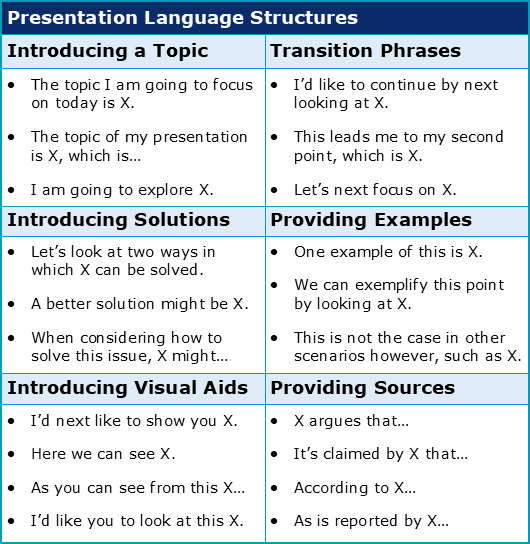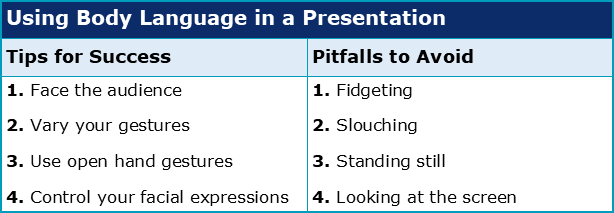Which 7 delivery strategies are most effective?

This is the second of three chapters about Delivery Strategies. To complete this reader, read each chapter carefully and then unlock and complete our materials to check your understanding.
– Introduce seven tips for successful presentations
– Explore each tip in relation to academic contexts
– Provide images and examples to help engage the readeer
Before you begin reading...
-
video and audio texts
-
knowledge checks and quizzes
-
skills practices, tasks and assignments
Chapter 2
In Chapter 1 we discussed the different types of presentation, explored the four features of this performance type, and determined the importance of delivery strategies in particular when presenting in academic contexts. In this second chapter on the topic, we next turn our attention to the seven most important strategies for delivering an effective academic presentation. Any student that wishes to score highly in an assessed presentation or any academic who wishes to be well received at a conference should learn, memorise and replicate the following tips for success.
Seven Tips for Success
1. Practice Sufficiently
One of the most important tips for success when delivering any type of presentation is to make sure that you’ve practised that presentation many times. First-year university students in particular are prone to neglecting the out-loud practice of their presentation until the last minute, which doesn’t leave enough time to consider all of the tips and pitfalls we’ve included in this short chapter. How could a presenter know, for example, whether their presentation is at the appropriate length if they haven’t practised it with a timer? And if it isn’t at the appropriate length, then that presenter will still need considerable time in order to shorten or lengthen it.

When practising, however, it’s important that you don’t memorise every word of your presentation or you could end up sounding too rehearsed. In truth, your speech should be slightly different every time you practise it, using different words to deliver the same content. Instead of memorising it, know your presentation well, settle on some key phrases, and try recording yourself presenting out loud – or stand in front of a mirror. Doing so should also help you to see any other elements of delivery that could be improved.
2. Be Confident
You’ve heard it before and you’ll hear it again: confidence is key. Even if you’re feeling nervous, the more confident you can appear to your audience the more likely they’ll be persuaded by your arguments. Practice can help significantly with this, as can smiling, making eye contact with your audience, having a good knowledge of your content, ensuring effective research, and creating a well-designed PowerPoint presentation. Begin your talk confidently and clearly and your audience should be immediately engaged by your performance.
3. Focus on Pronunciation
Elements of pronunciation are also very important when improving the delivery of a presentation. It’s perfectly normal to have an accent when speaking English (everyone has one), but if your accent is impeding understanding or you’ve mispronounced some key words, your audience will likely have to work harder to understand you – limiting the transfer of knowledge. When practising in front of the mirror, pay attention not only to your pronunciation and word stress but also to your volume, pitch, pace – slower is generally better – and whether you use an appropriate amount of pauses. An effective speaker tends to present at a pace that everyone can follow and at a volume that all can hear, and uses well-timed pauses to allow their speaker to think about the issues being described.
4. Memorise Language Models
As is outlined in more detail in our short chapter on presentation language, it’s also important that a speaker is able to utilise key language structures to signpost a presentation or signal any transitions and new sections. When considering the pace of your presentation, functional phrases such as those provided below should generally be said more quickly than phrases describing your key content:

5. Include Body Language
Because there are many gestures for students to learn, Academic Marker has also created a short chapter on body language which students delivering academic presentations may find worth studying. To summarise it for you here with reference to delivery strategies in particular, below are some of the key methods for demonstrating successful body language:

6. Interact with Your Presentation
While it might certainly be important to turn your body towards your audience, it’s important also that a presenter is able to incorporate any visual aids that they’ve used alongside their delivery and body language. Gesturing towards a PowerPoint slide, for example, can be extremely important when describing data such as graphs or charts. In addition to such gestures, the presenter should always remember to verbally introduce and explain any visuals being used, highlight important information from those visuals to the audience, describe any main trends and comment on the data’s significance. By remembering to do this, your audience should feel that you’re better interacting with both them and the supporting elements of your presentation.

7. Use Notes and a Clicker
One final recommendation when delivering an academic presentation is to use notes and a clicker. While a presenter can use handheld notes, don’t forget that a PowerPoint presentation can also act as digital notes and prompts for you. Should you forget something during the presentation, then such notes should help to bring you back on track.
Additionally, a remote USB clicker that can change the slides of a presentation is also very useful in that it enables the presenter to move away from the computer when presenting. An agile presenter is quite often seen as an engaging presenter, and the clicker will enable you to move more freely about the stage.
Now that we’ve discussed the seven most important tips for successful delivery of a presentation, continue on to Chapter 3 to find out about the seven pitfalls that an effective presenter should avoid.
Downloadables
Once you’ve completed all three chapters about delivery strategies, you might also wish to download our beginner, intermediate and advanced worksheets to test your progress or print for your students. These professional PDF worksheets can be easily accessed for only a few Academic Marks.
Collect Academic Marks
-
100 Marks for joining
-
25 Marks for daily e-learning
-
100-200 for feedback/testimonials
-
100-500 for referring your colleages/friends